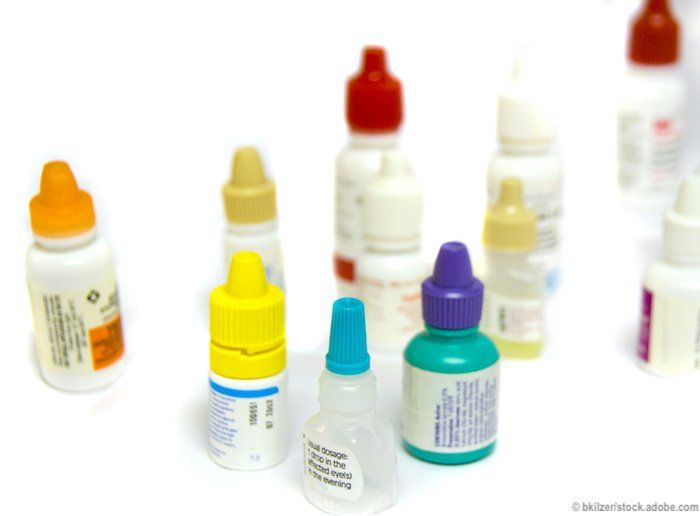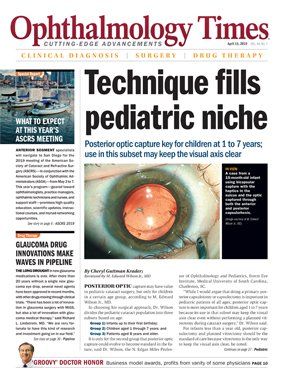Publication
Article
Digital Edition
Pharmacologic pipeline makes waves in glaucoma
Author(s):
Eye drops, drug-delivery system innovations aim to improve outcomes, adherence

With new agents approved and more new drugs moving through the pipeline, there is plenty of innovation occurring for the treatment of glaucoma.
The long drought in new glaucoma medications is over. After more than 20 years without a single new glaucoma eye drop, several therapeutic agents have been approved in recent months, with other novel drugs moving through clinical trials.
“There has been a lot of innovation in glaucoma surgery with MIGS, but also a lot of innovation with glaucoma medical therapy,” said Richard L. Lindstrom, MD, founder and attending surgeon, Minnesota Eye Consultants, and adjunct clinical professor emeritus of ophthalmology, University of Minnesota.
The most recent approval in March 2019 is a combination of netarsudil and latanoprost (Rocklatan) from Aerie Pharmaceuticals. Pooled data from the phase III Mercury trials showed the once-daily combination is more effective at lowering IOP than either of its ingredients used as a single agent. The combination is being pitched as a single-product alternative to multiple eye drops, which could improve adherence as well as therapeutic effect.
Aerie Pharmaceuticals had its first FDA approval in 2018 with netarsudil (Rhopressa), a Rho kinase inhibitor, or ROCK inhibiter, that works differently from other currently approved classes of glaucoma agents. Netarsudil reduces aqueous humor production, increases uveoscleral outflow and increases trabecular meshwork outflow.
Another recent introduction is latanoprostene bunod ophthalmic solution (Vyzulta, Bausch + Lomb), a prostaglandin analogue that also releases nitric oxide. The single molecule is metabolized into two active moieties, latanoprost acid and nitric oxide. The combination facilitates aqueous humor outflow through both the uveoscleral and trabecular meshwork pathways.
Nitric oxide is an endogenous signaling molecule that increases the permeability of the trabecular meshwork to enhance aqueous humor outflow. It activates the soluble guanylate cyclase-cGMP cascade to inhibit Rho kinase and lower intracellular calcium levels to mediate cell relaxation in the trabecular meshwork to improve outflow.
Also new is the first (benzalkonium chloride) BAK-free formulation of latanoprost drops. The once-daily, BAK-free formulation was developed by Sun Pharma Advanced Research Co., Sun Pharma’s R&D division. The formulation is stable at room temperature and could reduce the risk of BAK-associated ocular surface disease and will be marketed in the United States by Sun Ophthalmics.
Delivery systems
Eye drops work well in glaucoma, but only when patients are compliant. New drug-delivery systems offer the hope of improved therapeutic outcomes by taking patient adherence out of the loop.
Punctal plugs that elute travoprost and latanoprost agents are in development. Ocular Therapeutix has phase I trials following preclinical data showing sustained zero-order drug release and a marked reduction in IOP. Clinical data to date show sustained IOP reduction for up to 150 days using a hydrogel formulation.
Mati Therapeutics uses a harder plug material that is easy to insert and remove. Phase II data from the Evolute plug shows sustained drug release over 12 weeks.
Allergan has two delivery devices in development, a bimatoprost eluting ring and an injectable formulation. Both are showing very good efficacy in reducing intraocular tension, and both offer the opportunity to improve outcomes in patients with adherence problems.
A variety of innovators big and small are working on everything from printing latanoprost microdots (Enovia) to new Rho kinase inhibitors or more familiar prostaglandin analogs delivered via ocular implants (Glaukos/D. Western Therapeutics Institute) and even gene therapy using adenoviral vectors to deliver therapeutic genes into retinal ganglion cells to enhance survival (Astellas/Quethera).
BioMed/Manner Research and Aerpro are both developing a Tier 2 activating molecule targeting glaucoma. BioMed is working on POAG while Aerpro is working on POAG associated with diabetes.
Neuroprotection is another active field, and Noveome Biotherapeutics is working on a human placental cell extract using intranasal delivery for neuroprotection. Disarm Therapeutics is developing a neuroprotective agent using a selective androgen receptor modulator (SARM) inhibitor.
Allergan had worked on oral memantine as a potential neuroprotective agent. Unfortunately, trials in nearly 2,300 patients comparing two doses of memantine and placebo found no effect on glaucoma visual field progression or optic nerve changes.
ONL Therapeutics has shown neuroprotection for retinal cells even after IOP elevation.
At least three companies, Nemus BioScience, InMed Pharmaceuticals, and Axim Biotechnologies, are working on a POAG agent based on cannabinoids.
“There is plenty of innovation still coming for the treatment of glaucoma,” Dr. Lindstrom concluded.
Disclosures:
Richard L. Lindstrom, MD
E: rllindstrom@mneye.com
This article was adapted from Dr. Lindstrom’s presentation at the 2018 meeting of the American Academy of Ophthalmology. Dr. Lindstrom has no financial interests to report.

Newsletter
Don’t miss out—get Ophthalmology Times updates on the latest clinical advancements and expert interviews, straight to your inbox.




